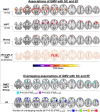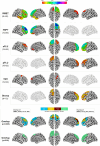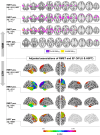Dissecting neural correlates of theory of mind and executive functions in behavioral variant frontotemporal dementia
- PMID: 39462381
- PMCID: PMC11515257
- DOI: 10.1186/s13195-024-01596-4
Dissecting neural correlates of theory of mind and executive functions in behavioral variant frontotemporal dementia
Abstract
Behavioral variant frontotemporal dementia (bvFTD) is characterized by profound and early deficits in social cognition (SC) and executive functions (EF). To date it remains unclear whether deficits of the respective cognitive domains are based on the degeneration of distinct brain regions. In 103 patients with a diagnosis of bvFTD (possible/probable/definite: N = 40/58/5) from the frontotemporal lobar degeneration (FTLD) consortium Germany cohort (age 62.5±9.4 years, gender 38 female/65 male) we applied multimodal structural imaging, i.e. voxel-based morphometry, cortical thickness (CTH) and networks of structural covariance via source based morphometry. We cross-sectionally investigated associations with performance in a modified Reading the Mind in the Eyes Test (RMET; reflective of theory of mind - ToM) and five different tests reflective of EF (i.e. Hamasch-Five-Point Test, semantic and phonemic Fluency, Trail Making Test, Stroop interference). Finally, we investigated the conjunction of RMET correlates with functional networks commonly associated with SC respectively ToM and EF as extracted meta-analytically within the Neurosynth database. RMET performance was mainly associated with gray matter volume (GMV) and CTH within temporal and insular cortical regions and less within the prefrontal cortex (PFC), whereas EF performance was mainly associated with prefrontal regions (GMV and CTH). Overlap of RMET and EF associations was primarily located within the insula, adjacent subcortical structures (i.e. putamen) and the dorsolateral PFC (dlPFC). These patterns were more pronounced after adjustment for the respective other cognitive domain. Corroborative results were obtained in analyses of structural covariance networks. Overlap of RMET with meta-analytically extracted functional networks commonly associated with SC, ToM and EF was again primarily located within the temporal and insular region and the dlPFC. In addition, on a meta-analytical level, strong associations were found for temporal cortical RMET correlates with SC and ToM in particular. These data indicate a temporo-frontal dissociation of bvFTD related disturbances of ToM and EF, with atrophy of the anterior temporal lobe being critically involved in ToM deficits. The consistent overlap within the insular cortex may be attributable to the multimodal and integrative role of this region in socioemotional and cognitive processing.
Keywords: Executive functions; Frontotemporal dementia; Magnetic resonance imaging; Reading the Mind in the Eyes Test; Social cognition; Theory of mind.
© 2024. The Author(s).
Conflict of interest statement
The authors declare no competing interests.
Figures





References
-
- Torralva T, Roca M, Gleichgerrcht E, Bekinschtein T, Manes F. A neuropsychological battery to detect specific executive and social cognitive impairments in early frontotemporal dementia. Brain. 2009;132(Pt 5):1299–309. 10.1093/brain/awp041. - PubMed
MeSH terms
Grants and funding
- FTLDc 01GI1007A/German Federal Ministry of Education and Research
- FTLDc 01GI1007A/German Federal Ministry of Education and Research
- FTLDc 01GI1007A/German Federal Ministry of Education and Research
- 01ED2008A/EU Joint Program-Neurodegenerative Diseases networks Genfi-Prox
- 01EW2008/EU Moodmarker program
LinkOut - more resources
Full Text Sources
Medical
Miscellaneous

